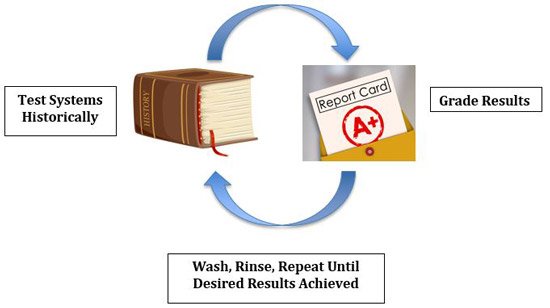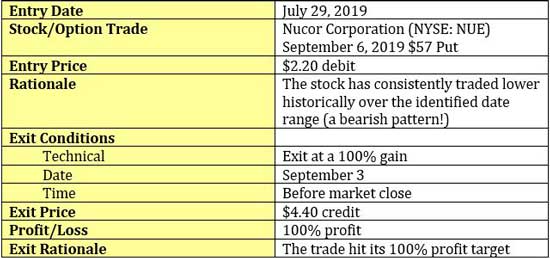Let’s face it. As humans, we are emotional beings. Happiness, sadness, fear, hope – it’s present in everything we do, whether we’re watching the news or running a marathon.
But trading on emotion can be the kiss of death. It can cause you to cut a winning trade short or let a losing trade run.
That’s why it’s absolutely crucial to separate emotions from trading if you want to make money in the stock market.
In fact, it’s the second step to becoming a successful trader.
I realize, though, that taking emotions out of trading is easier said than done. And that’s exactly why I’m here – to show you the simple solution.
So, here’s how to prevent yourself from making a potentially fatal mistake when it comes to your trading dreams…
The #1 Secret to Profitable, Stress-Free Trading
If you’ve ever traded, even for just five minutes, then chances are you’ve experienced one of two emotions: fear or greed. Fear of losing money, or greed towards making money.
But fear can cause many to exit a trade too early, missing out on an eventual profit. And greed can lead a once-profitable trade into a devastating loss. These feelings are natural – but if you let them guide your trading discipline, then you could end up in financial trouble.
Thankfully, there’s a simple solution. And that’s rules-based trading.
You know that I’m a pattern trader. I trade historical, proven patterns, and I use a firm set of rules in order to profit. These rules give me discrete entry and exit points that tell me exactly what to do and when to do it… even when I’m feeling emotions.
Yes, you heard me right. I’m not telling you to erase all of your emotions. When you watch your bank account pile up, it’s impossible not to feel a little bit greedy. But it’s important not to let those feelings influence your trading decisions. No matter how you’re feeling, it’s important to always stick to your trading rules.
A successful trader applies the following four principles, no matter what’s happening in the stock market:
- Specific Entry Points
Your entry rules should be very precise. Really, not much thinking needs to be involved when entering a position, as long as it meets all of your set requirements.
Your entry rules can really be anything. A particular volume pattern, an earnings move, or even simple fundamentals of a stock. There are many different options, but as long as you stick with your plan, you’re set up for success.
- Specific Exit Points
Exit rules are by far the most important part of successful trading. A common adage says it all: “Know your exits before you enter.” At minimal, your exit rules should include profit and loss exits.
For example, you could exit a position the moment it hits a 50% loss, or the moment you hit a 100% profit. That’s what Luke Nealson, one of my Weekly Money Call subscribers, did, and it paid off – literally.
“I exited at a 100% gain and made $1,022. Yahoo! My first option trade was amazing. Thanks Tom, you’re the best!”
That was Luke’s first option trade, and he made over $1,000! After success like that, he definitely won’t be skipping out on his exit rules.
You may also want to include technical exits or time exits. For example, you may want to specify an exit when the stock hits a particular moving average or to exit on a particular day.
The trick is this – even when you’re feeling the inevitable fear and greed that come with trading, always follow your exit rules.
- Repeatable
A great rules-based trader will produce a constant stream of trading opportunities. You aren’t going to be able to “run a railroad” executing just one trade a year.
This is precisely the reason I trade patterns. I mean, think about it – how would you define the word “pattern?” It’s something that repeats.
It’s right there in the name. By trading consistent, reliable patterns, you’ll always have new profit opportunities heading your way.
Perhaps this should be on the top of the list. Because when it comes down to it, trading success equals profits. In order to secure those profits, you need to make sure your rules produce the following characteristics:
- More Winners than Losers
To consider yourself a successful trader, you want to have at least a 60%-win rate. Really, you want to aim towards 80%. If you stick to rules-based trading, then you should see these results.
- Average Profits > Average Losses
You want your average winner to be twice the size of your average loser. For example, if your average winner is $500 and average loser is $250, you’re hitting the mark.

Mathematically, if both of the above conditions are true, then you’re ringing the cash register!
- Proven Through Testing
Our only guide in predicting the trading future is the past. Technical analysis is essentially all about distinguishing patterns in the past and counting on them to repeat in the future.
Before you begin rules-based trading, you should try out your broker’s paper trading engine. Think of it as a test run. Do at least 100 trades before you risk real money. If your trading rules satisfy all of the above, then consider trading real money.
Now, you can take less time testing if you have access to historic data. This allows you to accomplish months of testing in a single sitting. That’s exactly what I do in my V3 Trader program. It’s called “back-testing,” and with it we’re able to use historical patterns to rake in some seriously impressive gains.
In fact, we’ve studied billions of historical data points over at V3 and can pinpoint winners with 94% accuracy. Because of this, we can have the power to rake in thousands of dollars a month in potential profits over and over again. It’s all thanks to the historical data, and you can see exactly how we do it right here.
 Trade Plan
Trade Plan
To manage your trade, you always need a trade plan that uses all aspects of the trade. Check out the sample trade plan below from my Money Calendar Pro service…

Now remember… this is just an example of how you can set up your own plan. This is not a recommendation for you to trade – and even if you tried, you wouldn’t be able to since the option’s expired.
With all your decisions made beforehand, your trade plan will be your guide through thick and thin. No matter what you’re feeling (e.g. greed or fear), all of your exit conditions are “caste in stone.”
All you have to do is follow the rules.
From the Mailbag…
Reader: New retiree here. Now that I’m out of the office, I need to make the most out of my strict income and I don’t want to spend all day by the computer. Should I stick to buying stocks and holding on to them? What about dividends? I’ve got a few in my fund now… but I’m only earning a few cents. Any advice?
Tom: First off, congrats on your retirement! A lot of people think that the “safest” or “best” way to make money once you stop working full time involves holding onto stocks… but that’s not going to help you grow your wealth quickly. And if you’re anything like me, you don’t just want to sit around waiting for your next check – you want to be living the retirement of your dreams. For a chance to do that, you’re going to want to use a proven, profit-generating system (like my Alpha-9). This gives you a consistent stream of opportunities for as long as you use it. Plus, because the system is doing a lot of the heavy lifting, you only have to spend five minutes a day setting up your trades. No sitting at your computer all day, no searching the market for the best opportunities, and no measly dividend checks – just real, money-generating opportunities every single day! What’s better than that?!
Reader: All of my buddies think we’re heading into a recession – what’s your take?
Tom: Here’s the thing – historically, bull markets only last about five years. So we’re overdue for a major correction…
I suggest you make sure your portfolio doesn’t take a hit by insuring your stock “property” with puts and covered calls. With this strategy, you’re ensuring that regardless of which way the market turns – bullish or bearish – you’ll be protected. I dig into this with a few examples right here.
Good trading,

Tom Gentile
America’s #1 Pattern Trader